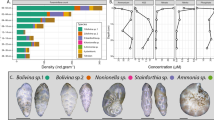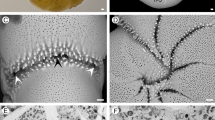Abstract
Foraminifera are known to obtain nutrients in a variety of ways: they are omnivores, carnivores or herbivores1–3 and some species are known to use the extracellular metabolites of their photosynthetic endosymbionts1,2,4. None, however, has previously been proven to utilize exogenous dissolved organic carbon directly, although this is well known in other marine species5,6. Knowledge of foraminiferal trophic positions is important because foraminifera are common in most marine communities1 and may be the most abundant eukaryotic organism in the extensive deep-sea benthos7–9. Our studies of benthic foraminifera from an unusual Antarctic shallow water embayment now show that certain species utilize both particulate and dissolved organic material in their nutrition.
This is a preview of subscription content, access via your institution
Access options
Subscribe to this journal
Receive 51 print issues and online access
$199.00 per year
only $3.90 per issue
Buy this article
- Purchase on Springer Link
- Instant access to full article PDF
Prices may be subject to local taxes which are calculated during checkout
Similar content being viewed by others
References
Boltovsky, E. & Wright, R. Recent Foraminifera (The Hague, 1976).
Lee, J. J. in Foraminifera (eds Hedley, R. H. & Adams, C. G.) 207 (Academic, London, 1974).
Lee, J. J. et al. J. Protozool. 13, 659–670 (1966).
Smith, D. F. & Wiebe, W. J. Aust. J. Fish. Fresh. Res. 28, 311–319 (1977).
Jorgensen, C. B. Biol. Rev. 51, 291–328 (1976).
Stevens, G. C. in Symp. Nitrogen Metabolism and the Environment (eds Campbell, J. W. & Goldstein, C.) 155–184 (Academic, New York, 1972).
Hessler, R. R. in The Biology of the Oceanic Pacific (ed. Miller, C. B.) 79–93 (Oregon State University Press, Corvalis, 1974).
Tendal, O. & Hessler, R. R. Galathea Rep. 14, 165–194 (1977).
Smith, K. L. Jr Mar. Biol. 47, 337–347 (1978).
Littlepage, J. L. Antarct. Res. Ser. 14, 1–37 (1971).
Dayton, P. K. & Oliver, J. S. Science 197, 55–58 (1977).
North, B. B. Limnol. Oceanogr. 20, 20–27 (1975).
Karl, D. M. Appl. envir. Microbiol. 38, 850–860 (1979).
DeLaca, T. E., Lipps, J. H. & Hessler, R. R. J. Linn. Soc. Land. Zool. 69, 205–224 (1980).
Author information
Authors and Affiliations
Rights and permissions
About this article
Cite this article
DeLaca, T., Karl, D. & Lipps, J. Direct use of dissolved organic carbon by agglutinated benthic foraminifera. Nature 289, 287–289 (1981). https://doi.org/10.1038/289287a0
Received:
Accepted:
Issue Date:
DOI: https://doi.org/10.1038/289287a0
This article is cited by
-
Kleptoplast distribution, photosynthetic efficiency and sequestration mechanisms in intertidal benthic foraminifera
The ISME Journal (2022)
-
Enrichment of intracellular sulphur cycle –associated bacteria in intertidal benthic foraminifera revealed by 16S and aprA gene analysis
Scientific Reports (2019)
-
Quantifying pelagic-benthic coupling in the North Sea: Are we asking the right questions?
Senckenbergiana maritima (2001)
-
Microbial growth dynamics on the basis of individual budgets
Antonie van Leeuwenhoek (1991)
Comments
By submitting a comment you agree to abide by our Terms and Community Guidelines. If you find something abusive or that does not comply with our terms or guidelines please flag it as inappropriate.



